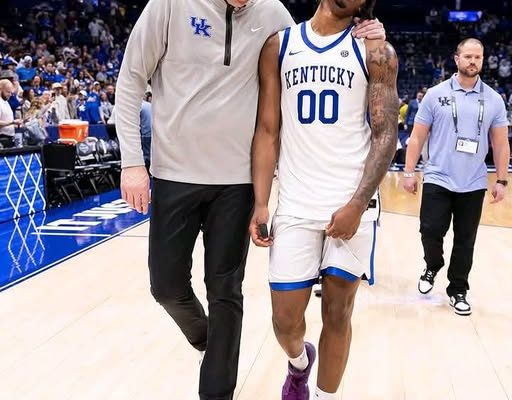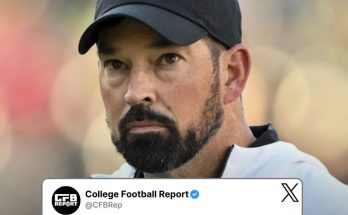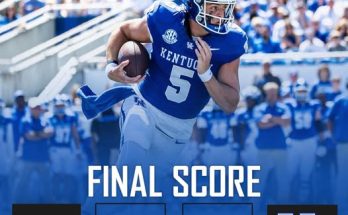Mark Pope, the head coach of the BYU men’s basketball team, recently made waves in the college basketball world with a statement that is sending shockwaves through programs across the nation. In an interview following a dominant performance by his team, Pope made a bold declaration about Otega Oweh, one of the rising stars in the sport, saying plainly that Oweh is “built different.” While at first glance this may sound like the kind of casual, locker-room bravado often tossed around in postgame interviews, the implications of Pope’s statement run much deeper. When a coach of Pope’s caliber—someone known for his meticulous attention to player development and scouting—makes such a proclamation, the rest of college basketball should take notice.
Otega Oweh, a name that has been generating buzz among scouts, analysts, and fans alike, is beginning to show why he is considered one of the most unique athletes in college basketball. Physically, he is an imposing figure, standing tall with a combination of speed, agility, and explosive athleticism that is rarely seen at the collegiate level. But what sets him apart is not just his physical tools—it is the way he applies them on the court. Pope’s comment about Oweh being “built different” is not mere hyperbole; it speaks to a rare combination of attributes: the ability to dominate on both ends of the floor, an uncanny understanding of spacing and timing, and a competitive fire that refuses to be subdued by even the most elite opponents.
One of the aspects that makes Oweh so formidable is his defensive versatility. In an era where college basketball is increasingly defined by positionless play, Oweh stands out as a player capable of guarding multiple positions without compromising effectiveness. He can switch seamlessly from perimeter defense to interior presence, a skill that disrupts offensive schemes and forces opponents to constantly adjust. This adaptability is something that Pope has repeatedly emphasized in interviews as a trait that makes Oweh not just a good player, but a transformative one. In other words, the kind of player who can change the dynamics of an entire game with his presence.
On the offensive side, Oweh’s game is equally impressive. He combines athleticism with basketball IQ, making him a threat in transition as well as in half-court sets. His ability to read defenses, anticipate rotations, and make split-second decisions allows him to create scoring opportunities not only for himself but also for his teammates. It’s this dual-threat capability that makes him particularly dangerous; he is not a one-dimensional athlete who relies solely on raw talent. Instead, he leverages his physical gifts intelligently, elevating the play of everyone around him. Mark Pope’s praise is a reflection of this intelligence, acknowledging that Oweh’s impact is both immediate and profound.
Beyond the tangible skills, Pope’s statement also hints at something less quantifiable but equally important: Oweh’s mental makeup. To be “built different” in the context of high-level college basketball requires more than physical tools; it demands resilience, focus, and an unyielding work ethic. Reports from practices, team interactions, and scouting sessions indicate that Oweh approaches the game with a seriousness and maturity that belies his age. He is known for spending extra hours refining his craft, studying opponents, and working on nuances that many players overlook. Coaches like Pope, who have seen countless talented athletes come through their programs, recognize immediately when a player possesses this rare combination of drive and discipline. In Oweh, Pope sees a player who is not just talented but fundamentally elite in preparation, mindset, and execution.
The ripple effect of a player like Oweh on college basketball programs cannot be overstated. Teams that are accustomed to relying on conventional strategies may find themselves struggling to adjust to his unique blend of size, speed, and intelligence. Recruiting strategies could shift, as programs scramble to find athletes who can match his physical profile or develop the versatility he embodies. Defensively, opponents will need to rethink their rotations, pick-and-roll coverages, and transition schemes. Offensively, coaches may need to account for his ability to create chaos in the paint, force turnovers, and push the pace at a level that few other players can sustain. In short, Oweh represents a paradigm shift in how college basketball talent can influence the game.
Furthermore, Oweh’s presence elevates the profile of his program in ways that go beyond wins and losses. For BYU, having a player of this caliber draws national attention, increases fan engagement, and enhances the program’s recruiting appeal. Young athletes across the country now see a tangible example of the heights they can reach under Pope’s guidance. It also places pressure on rival programs to not only compete on the court but also to innovate off it—developing training methods, nutritional programs, and tactical approaches designed to cultivate similarly exceptional talent. The competitive bar has been raised, and the ripple effects will be felt across the NCAA landscape.
It is also worth noting the timing of Pope’s statement. College basketball is entering a period of heightened scrutiny and evaluation, with the transfer portal, NIL deals, and evolving professional pathways adding layers of complexity to player development. In this context, a player like Oweh becomes not only a game-changer on the floor but also a case study for how talent is identified, nurtured, and showcased in the modern era. Coaches, analysts, and scouts will be watching his every move, dissecting film and performance metrics to understand what makes him different. Pope’s remark serves as both a warning and an acknowledgment: the rest of the nation must pay attention because Oweh is not just another standout athlete; he represents the next tier of college basketball excellence.
The comparison to other elite athletes is inevitable. While it is tempting to place Oweh in a category with past collegiate phenoms, Pope’s description implies that Oweh may occupy a space even more rarefied. “Built different” is a phrase often used loosely, but in this context, it suggests a combination of factors—physicality, skill, intelligence, and mental toughness—that is seldom seen together. For opposing coaches, this presents a daunting challenge: how do you prepare your team for a player who defies conventional scouting reports and statistical projections? How do you design a game plan when your opponent has someone capable of changing the dynamics of virtually every possession?
From a tactical perspective, Oweh’s versatility forces coaches to innovate. Traditional defensive schemes that rely on set matchups may be insufficient. Double teams, zone variations, and adaptive switching strategies may all be necessary, but none of them come with guarantees. On offense, players must anticipate his ability to disrupt passing lanes, contest shots, and create fast-break opportunities. The psychological aspect cannot be overlooked either; facing an athlete whose presence alone can alter decision-making adds a layer of stress that can impact performance over the course of a game, or even a season. Mark Pope’s warning, therefore, is as much about mindset as it is about skill—it is a signal that college basketball is entering a phase where conventional wisdom may no longer be adequate.



